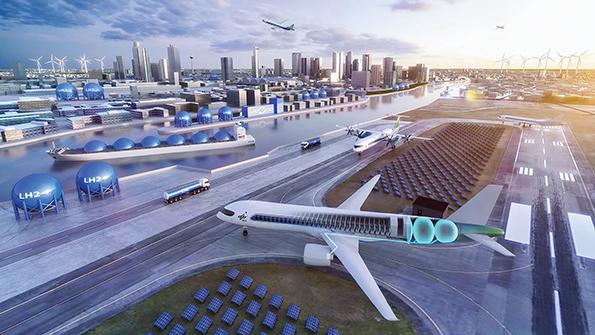

As hydrogen-fueled propulsion technologies gain interest and investment, industry needs to make timely strategic infrastructure decisions, presentations and panel discussions at ILA Berlin indicate.
The alternative fuel, whether burned in a gas turbine or powering a fuel cell, is gaining credibility in more studies and interest from investors, despite the current early stage of European research, attendees at the June 22-26 show learned.
- Energy requirement estimates show favorable results
- Supply chain has to begin investing now
June 22 was the day when Clean Aviation’s first call for proposals, worth €736 million ($769 million), closed. Hydrogen’s place in the EU public-private initiative is significant, as indicated by the €115 million that Clean Aviation has alloted to the “direct combustion of hydrogen in aero engines” topic.
On the same day, the chief technology officers of seven companies involved committed to collaborating on topics that would otherwise be competitive issues. “We first need to win the race for 2050 [the target for climate neutrality], and then we will worry about the rest,” Nicole Dreyer-Langlet, Airbus vice president for research and technology in Germany, said at the event. “We can only be in it as a team.”
“This is an opportunity to be all together and introduce a new technology with impact in mind,” added Nathalie Duquesne, Liebherr-Aerospace Toulouse managing director.
Burning hydrogen in a gas turbine is the industry’s preferred pathway for the use of hydrogen, but fuel cells remain an option. In three different scenarios, Bauhaus Luftfahrt, a Munich-based aviation science and technology think tank, compared the energy requirement (measured from gate to gate) of an evolutionary conventional-fuel aircraft in 2035 with that of a baseline hydrogen aircraft using gas turbines. Due to the larger tanks and accompanying structural differences and systems, a baseline hydrogen aircraft incurs a penalty, Kathrin Ebner, Bauhaus Luftfahrt’s strategic research coordinator for hydrogen aviation, said at the air show. But she was happy to find that the right type of fuel cell, possibly combined with gas turbines, can bring the energy requirement down to the same level as the evolutionary aircraft.
Bauhaus Luftfahrt has also studied proposed hydrogen infrastructures. Synergies in hydrogen production could be found with other sectors. Because aviation would need liquid hydrogen (LH2) as opposed to gaseous hydrogen for its greater energy density, transportation would have to be optimized for LH2.
As for liquefaction, the commercial air transport industry should take advantage of those sites where renewable energy is cheapest. Both electrolysis and liquefaction should take place there, Ebner recommended. “The benefits from LH2 production at a favorable location outweigh the penalties associated with LH2 transport,” she said.
Airbus and Linde, a global industrial gases and engineering company, have broadened their cooperation agreement to study the logistical aspects of hydrogen use in aviation. They will look for the best routes for the hydrogen ecosystem to feed airports. “After 2035, the hydrogen that Europe’s aviation will need may be produced in the Middle East, Australia or Chile,” explained Philippe Peccard, Linde vice president of clean energy. “We are notably targeting airports in Germany for them to get familiarized.”
Lufthansa Technik has launched a “hydrogen aviation lab” to study the impact of a hydrogen system on aircraft operations. The delivery of a decommissioned A320 is scheduled for July. It will be equipped with a liquid-hydrogen tank and fuel cell and will serve as a testbed.
To start with, testing will take place at a relatively small scale: The fuel cell will power galley equipment.
Meanwhile, the supply chain for commercial aircraft manufacturing has to start investing now in those technologies that OEMs will need to decarbonize aviation. Yet for small and medium-size businesses, finding the time and money is a serious hurdle. They are recovering from the COVID-19 crisis and striving to ramp up production.
Airbus is aiming at a 2035 service entry target for a hydrogen-powered aircraft, hinging on a 2027-28 program launch. Suppliers are expected to be selected in 2025-27.
“In 2025, a number of the required technologies will have to be ready,” Norbert Steinkemper, vice president of communication and marketing at factory equipment specialist Broetje-Automation, said at the event.
Complicating investment decisions is the uncertainty about which technologies OEMs will pick. “Will it really be hydrogen?” Steinkemper asked. “Will the airframe move to the blended wing-body architecture?
“Ten years from now, suppliers will not receive much revenue from greener aircraft,” Steinkemper said. “Yet the investments they have to go ahead with are huge. Take hydrogen tank technology—composites could be the way to go for lighter tanks, but current carbon-fiber reinforcements are not suitable. They have to be made stronger, and expensive tests are needed.”


